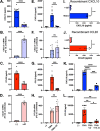Depletion of Extracellular Chemokines by Aspergillus Melanin
- PMID: 37067432
- PMCID: PMC10294650
- DOI: 10.1128/mbio.00194-23
Depletion of Extracellular Chemokines by Aspergillus Melanin
Abstract
Aspergillus fumigatus is an environmental fungus that can cause life-threatening pulmonary disease. Infections initiate when conidia are inhaled and land deep inside the small airways and alveoli of the lungs, where they interact with epithelial cells. These cells provide a physical barrier and secrete chemokines to attract innate immune cells to the site of infection. Melanin, a key constituent of the conidial cell wall, is required for the establishment of invasive infection due to its ability to inhibit the function of innate immune cells recruited to clear the infection. Here, we provide evidence for an additional mechanism by which A. fumigatus can alter host innate immune responses. In vitro infection of a normal human small airway epithelial cell line (HSAEC1-KT) caused a decrease in extracellular protein levels of CXCL10 and CCL20, two proinflammatory chemokines that are required for the host defense against aspergillosis, despite a dramatic increase in the levels of each mRNA. A. fumigatus depleted recombinant human CXCL10 and CCL20 from medium in the absence of host cells, suggesting that the block in accumulation is downstream of protein translation and secretion. Melanin is both necessary and sufficient for this chemokine-depleting activity because a dihydroxynaphthalene (DHN)-melanin-deficient strain of A. fumigatus is defective in depleting chemokines and purified melanin ghosts retain potent depletion activity. We propose that A. fumigatus, through the action of melanin, depletes important chemokines, thereby dampening the innate immune response to promote infection. IMPORTANCE Aspergillus fumigatus is the major airborne fungal pathogen that affects humans. In order to cause an invasive infection, inhaled spores must avoid killing by innate immune cells that are recruited to the site of infection. Understanding how A. fumigatus achieves immune evasion is important for the development of novel therapeutics. We provide evidence that melanin, a pigment contained in the spore cell wall, can remove certain chemokines from the extracellular space to suppress the host inflammatory response that is responsible for clearing fungal infection.
Keywords: Aspergillus fumigatus; CCL20; CXCL10; airway epithelial cells; chemokines; melanin.
Conflict of interest statement
The authors declare no conflict of interest.
Figures


References
-
- Caffrey AK, Lehmann MM, Zickovich JM, Espinosa V, Shepardson KM, Watschke CP, Hilmer KM, Thammahong A, Barker BM, Rivera A, Cramer RA, Obar JJ. 2015. IL-1alpha signaling is critical for leukocyte recruitment after pulmonary Aspergillus fumigatus challenge. PLoS Pathog 11:e1004625. doi:10.1371/journal.ppat.1004625. - DOI - PMC - PubMed

